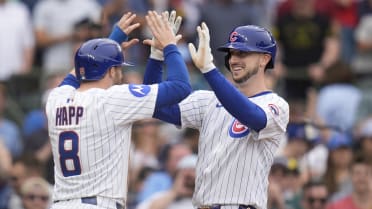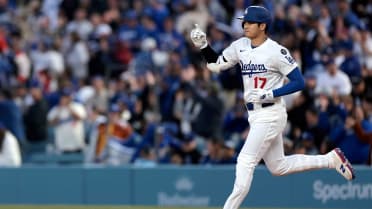DENVER -- The Rockies and right-handed pitcher Jon Gray will finally receive what any relationship needs to survive, or not: information.
The decision not to to give Gray a qualifying offer, worth $18.4 million for 2022, before Sunday's deadline, and Gray not signing an extension offer during the season, reported by The Athletic at three years in the $35 million-$40 million range, were born of the same concern: A need for more info on Gray’s market.
These mechanics leave the Rockies staring at risk. By deciding not to deal Gray at the 2021 Trade Deadline, then also not granting the qualifying offer, the Rockies risk losing Gray for none of the players a trade would have brought, or the 2022 MLB Draft pick that would have been theirs had he turned down the qualifying offer and gone elsewhere. Shortstop Trevor Story received the qualifying offer.
But Gray’s market worth, at least, will be revealed. That worth will determine what the Rockies and Gray do next.
After the World Series, Gray, 30, became a free agent for the first time in his career. He had said repeatedly during the season that he wants to stay with the club, hence the team’s decision not to deal him at the Trade Deadline and its reported offer. But Gray’s desire to stay clearly did not constitute a guarantee.
Now, beyond what the Rockies’ reported offer, what is Gray’s true worth? Gray, represented by agent Jeff Barry, now can accept offers and see if the Rockies are willing to top them.
Starter-poor teams have a direct task -- outbid the Rockies. Already, Twitter is abuzz with fans of the Cubs (believed to have been among the teams that attempted to trade for Gray after the 2019 season), the Angels and the Dodgers, all with Gray on their wish list.
The wasn’t enough information for Gray to sign in the summer. And on Sunday, new Rockies general manager Bill Schmidt decided there wasn’t enough information to justify Gray possibly accepting the $18.4 million 2022 price tag that came with the qualifying offer.
The QO value is out of line with the current rotation’s earnings for ’22 -- Germán Márquez at $11.3 million, Antonio Senzatela at $7.5 million and Kyle Freeland, projected by MLB Trade Rumors and Cot’s Baseball Contracts at $7 million via arbitration.
Multiple club officials have said the team is still trying to re-sign Gray. The offer during the season -- Schmidt has refused to confirm terms of the reported offer -- was by no means final. The difference now is they will likely be bidding against other teams.
Gray’s decision to invite other teams into the bidding does not appear to be a surprise. At no point during Gray’s three years of arbitration was there momentum toward a multi-year deal, and throughout the late summer they took a “we’ll see” approach to extension talks.
The offseason is young, but there is no indication the Rockies will back away from a plan to increase payroll spending this winter, and by 2023 return to something approaching the club record of just under $152 million doled out in 2019. Contract extensions for Senzatela and first baseman C.J. Cron (two years, $14.5 million) were the first offseason moves.
But losing Gray would be a blow. The Rockies like their rotation enough to pursue hitters and dream, but they know experience and depth is lacking.
How would they replace Gray should he leave? Free agency has always been dicey for the Rockies, but there are other methods. Going with homegrown products has generally been more successful than free agency, but righty Peter Lambert's 21 starts over three seasons (interrupted by Tommy John right elbow surgery) represent the most experience from the system. The Rockies have found quality through trades for pitchers early in their careers, with Márquez and lefty Austin Gomber serving as examples from the current rotation.
Keeping Gray is the preferred option. But what is Gray’s salary potential? Until other bids are in, it’s at least instructive to compare to members of a Rockies rotation -- one that the team thinks is good enough for the front office to pursue offense and dream.
Earnings for Márquez, who signed a five-year, $43 million deal in ’19 (long before free agency), top out at $15.3 million in 2023. There is a $16 million club option in 2024. Senzatela will make $12 million each of the last three years of the five-year, $50.5 million contract he signed after the 2021 season.
The Athletic report of the offer put Gray at a $13.3 million max per year. Again, the club did not confirm the offer, and there is every indication that Colorado is willing to negotiate when other teams join the bidding.
There is precious little information on what the Rockies must do to retain their own starting pitching free agents.
When they’ve had a starter they’ve liked, they’ve signed him to a multi-year deal before he was eligible for free agency.
Márquez, Senzatela and, years back, Ubaldo Jiménez, Aaron Cook and Jeff Francis all signed before they were eligible for free agency. But Gray never reached such a deal during his arbitration years, and it has yet to happen with Freeland. Tyler Chatwood reached free agency with the Rockies, but the club did not make a push to retain him before he jumped to the Cubs after the ’17 season.
To find the last time that a starter the Rockies wanted to retain hit free agency, you go back to Jorge De La Rosa, who stayed under a two-year, $21.5 million contract covering 2011-12. At the end of that contract, De La Rosa signed a two-year, $25 million extension without testing the market.
Now Gray and Rockies find themselves in a new information age.
Senior Reporter Thomas Harding has covered the Rockies since 2000, and for MLB.com since 2002.




